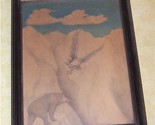1930 ORIGINAL FRAMED SIGNED ART EAGLE BEAR DRAWING OLD
GREETINGS, FEEL FREE
TO
"SHOP NAKED."
Features
Location Belgium
Type Unclassified exonumia ? Miscellaneous token
Year 1981
Value 100 Sinjoren (100)
Currency Belgium - Local Tokens
Composition Bronze (patinated bronze)
Weight 14.8 g
Size 30 mm
Thickness 2.6 mm
Shape Round
Orientation Medal alignment ??
Number N# 183439
Obverse
Coat of Arms of Antwerp
Lettering:
ANTWERPEN
1981
Reverse
Market in front of old houses
Lettering:
ALGEMENE MARTKTHANDELAARSVERENIGING
100 SINJOREN
Edge
Smooth
We deal in items we believe others will enjoy and want to purchase.
We are not experts.
We welcome any comments, questions, or concerns.
WE ARE TARGETING A GLOBAL MARKET PLACE.
Thanks in advance for your patronage.
Please Be sure to add WDG to your favorites list!
NOW FOR YOUR VIEWING PLEASURE?
"WHO - ME?"
by "DOLEN"
CIRCA 1920 - 1930
ORIGINAL HAND DRAWN PICTURE
DEPICTS A BALD EAGLE GUARDING ITS ROUST FROM A TRESPASSING GRIZZLY BEAR ON THE MOUNTAINSIDE
FRAMED UNDER GLASS
BY CITY ART STORE
315 SOUTH BOULDER
TULSA OKLAHOMA (OK)
CRAFTED IN COLORED PENCIL
THIS WORK OF REALISM IS TRULY
WELL DONE.
THE ARTIST IS MOSTLY UNKNOWN
HOWEVER THIS PIECE WILL LEAVE NO DISAPPOINTMENT
THE WOODEN FRAME MEASURES
10.5" BY 13.5"
SOFT PASTEL COLORS WITH BLUES AND GRAYS.
ARTISTIC RENDITION IS OF SOME AGE
AND SHOWS WELL.
PLEASE SEE MY ALTERNATE AUCTION BY THE SAME ARTIST.
THE OTHER OFFERING IS BIG HORN SHEEP AT PLAY.
----------------
FYI
Eagles are large birds of prey which mainly inhabit Eurasia and Africa. Outside this area, just two species (the Bald and Golden Eagles) are found in North America north of Mexico, with a few more species in Central and South America, and three in Australia.
They are members of the bird order Falconiformes (or Accipitriformes, according to alternative classification schemes), family Accipitridae, and belong to several genera which are not necessarily closely related to each other in any sort of way.
Eagles are differentiated from other birds of prey mainly by their larger size, more powerful build, and heavier head and bill. Even the smallest eagles, like the Booted Eagle (which is comparable in size to a Common Buzzard or Red-tailed Hawk), have relatively longer and more evenly broad wings, and more direct, faster flight. Most eagles are larger than any other raptors apart from the vultures.
Like all birds of prey, eagles have very large powerful hooked beaks for tearing flesh from their prey, strong legs, and powerful talons. They also have extremely keen eyesight to enable them to spot potential prey from a very long distance. This keen eyesight is primarily contributed by their extremely large pupils which cause minimal diffraction (scattering) of the incoming light.
In Britain before 1678, Eagle referred specifically to the Golden Eagle, the other native species, the White-tailed Eagle, being known as the Erne. The modern name "Golden Eagle" for Aquila chrysaetos was introduced by the naturalist John Ray.
Eagles build their nests, called eyries, in tall trees or on high cliffs. Many species lay two eggs, but the older, larger chick frequently kills its younger sibling once it has hatched.
Eagles are sometimes used in falconry. They appear prominently in myth and literature. In the Old World, such references are commonly to the Golden Eagle (or possibly closely related species found in warmer climates).
----------------
Bears (family Ursidae) are mammals in the order Carnivora. Bears are classified as caniforms, or doglike carnivorans, with the pinnipeds being their closest living relatives. Although there are only eight living species of bear, they are widespread, appearing in a wide variety of habitats throughout the Northern Hemisphere and partially in the Southern Hemisphere.
Common characteristics of modern bears include a large body with stocky legs, a long snout, shaggy hair, plantigrade paws with five nonretractile claws, and a short tail. While the polar bear is mostly carnivorous and the giant panda feeds almost entirely on bamboo, the remaining six species are omnivorous, with largely varied diets including both plants and animals.
With the exceptions of courting individuals and mothers with their young, bears are typically solitary animals. They are sometimes diurnal, but are usually active during the night (nocturnal) or twilight (crepuscular). Bears are aided by an excellent sense of smell, and despite their heavy build and awkward gait, they can run quickly and are adept climbers and swimmers. Bears use shelters such as caves and burrows as their dens, which are occupied by most species during the winter for a long period of sleep similar to hibernation.
Bears have been hunted since prehistoric times for their meat and fur. To this day, they play a prominent role in the arts, mythology, and other cultural aspects of various human societies. In modern times, the bear's existence has been pressured through the encroachment of their habitats and the illegal trade of bears and bear parts, including the Asian bile bear market. The IUCN lists six bear species as vulnerable or endangered, and even "least concern" species such as the brown bear are at risk of extirpation in certain countries. The poaching and international trade of these most threatened populations is prohibited, but still ongoing.
(PICTURES FOR DISPLAY ONLY)
(description exceeds maximum possible length)
